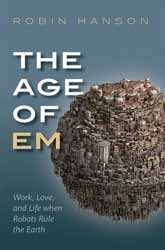|
Click here to return to the main site. Book Review
Robin Hanson is an economist and a research associate at the Future of Humanity Institute of Oxford University and is a great defender of the idea that you can use social science and economics to make viable predictions about the future. Although this book postulates a fictional future, it is not a work of fiction, rather the book reads like a university paper. I’m guess that if you're reading this you have an interest in speculative fiction in its many forms. In both book and film creators have taken us to strange and wonderous places, but as Robin Hanson points out in his new book, The Age of Em (2018. 506 pages), nobody gets the social and economic structure right. Star Trek addresses some of these points by getting rid of money and borrowing from Karl Marx’s "From each according to his ability, to each according to his needs", though this doesn’t address how they stop people from abusing the system. Picard would say that humanity has outgrown its acquisitive nature, but that does not account for Harcourt Fenton Mudd. So, what would a future really look like and how would it work? Hanson spends a long time setting out his postulations, routed in history to prove the change in innovation and man's journey from hunter gathers to an industrial economy are easily mapped. He shows how things have fundamentally changed and how the social constructions allowed for other changes. So, what is the great next change? According to Hanson brain emulation is less than one hundred years away. The ability to map the brain to create near perfect copies will bring its own monumental shifts in every aspect of human life and Hanson goes through these changes in minute detail. But what will it mean? If I make a copy of myself is it really me, will it even have any familial allegiance when its computerised brain will work faster and more efficiently? Personally, I think it holds the same existential angst as Star Trek’s transporters which effectively kill you and then reconstruct a copy somewhere else. There are not many books which pride themselves with adding more citations and references and even Hanson agrees that the book may be too heavy to read from cover to cover. Doing it this way was a bit of a slog, but if you read the opening chapters to understand the basis of his argument then the book also allows you to pick a subject heading and engage with the book in this way. Hanson takes a very dry look at his future where trillions of Em’s work, some in virtual environments, some with bodies. Being copies of human beings they continue with some of our own obsessions. Em sex is not discounted, but pair bonding becomes less important. Even death takes on a different context when Em’s can make temporary copies of themselves. When they are deleted are they dead? Running, as they do, at much higher speeds than humans, Hanson thinks that this next evolutionary phase may be quite short as the Em’s will likely crack AI within a year which will spark off another change. The book may be a bit on the heavy side but it’s well worth dipping into Hanson’s view of our potential future. I leave it up to you to decide if the world of Em’s represents a heaven or a hell. 8 Charles Packer Buy this item online
|
|---|


